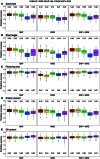Phenomic Selection for Hybrid Rapeseed Breeding
- PMID: 39049840
- PMCID: PMC11268845
- DOI: 10.34133/plantphenomics.0215
Phenomic Selection for Hybrid Rapeseed Breeding
Abstract
Phenomic selection is a recent approach suggested as a low-cost, high-throughput alternative to genomic selection. Instead of using genetic markers, it employs spectral data to predict complex traits using equivalent statistical models. Phenomic selection has been shown to outperform genomic selection when using spectral data that was obtained within the same generation as the traits that were predicted. However, for hybrid breeding, the key question is whether spectral data from parental genotypes can be used to effectively predict traits in the hybrid generation. Here, we aimed to evaluate the potential of phenomic selection for hybrid rapeseed breeding. We performed predictions for various traits in a structured population of 410 test hybrids, grown in multiple environments, using near-infrared spectroscopy data obtained from harvested seeds of both the hybrids and their parental lines with different linear and nonlinear models. We found that phenomic selection within the hybrid generation outperformed genomic selection for seed yield and plant height, even when spectral data was collected at single locations, while being less affected by population structure. Furthermore, we demonstrate that phenomic prediction across generations is feasible, and selecting hybrids based on spectral data obtained from parental genotypes is competitive with genomic selection. We conclude that phenomic selection is a promising approach for rapeseed breeding that can be easily implemented without any additional costs or efforts as near-infrared spectroscopy is routinely assessed in rapeseed breeding.
Copyright © 2024 Lennard Roscher-Ehrig et al.
Conflict of interest statement
Competing interests: A.A. and M.M. were employed by the company NPZ Innovation GmbH. S.A. and R.H. were employed by the company Limagrain GmbH. The remaining authors declare that they have no conflict of interest regarding the publication of this article.
Figures








References
-
- Bernardo R. Prediction of maize single-cross performance using RFLPs and information from related hybrids. Crop Sci. 1994;34(1):20–25.
-
- Heffner EL, Sorrells ME, Jannink J-L. Genomic selection for crop improvement. Crop Sci. 2009;49(1):1–12.
-
- Lynch M. Estimation of relatedness by DNA fingerprinting. Mol Biol Evol. 1988;5(5):584–599. - PubMed
-
- VanRaden PM. Efficient methods to compute genomic predictions. J Dairy Sci. 2008;91(11):4414–4423. - PubMed
LinkOut - more resources
Full Text Sources

